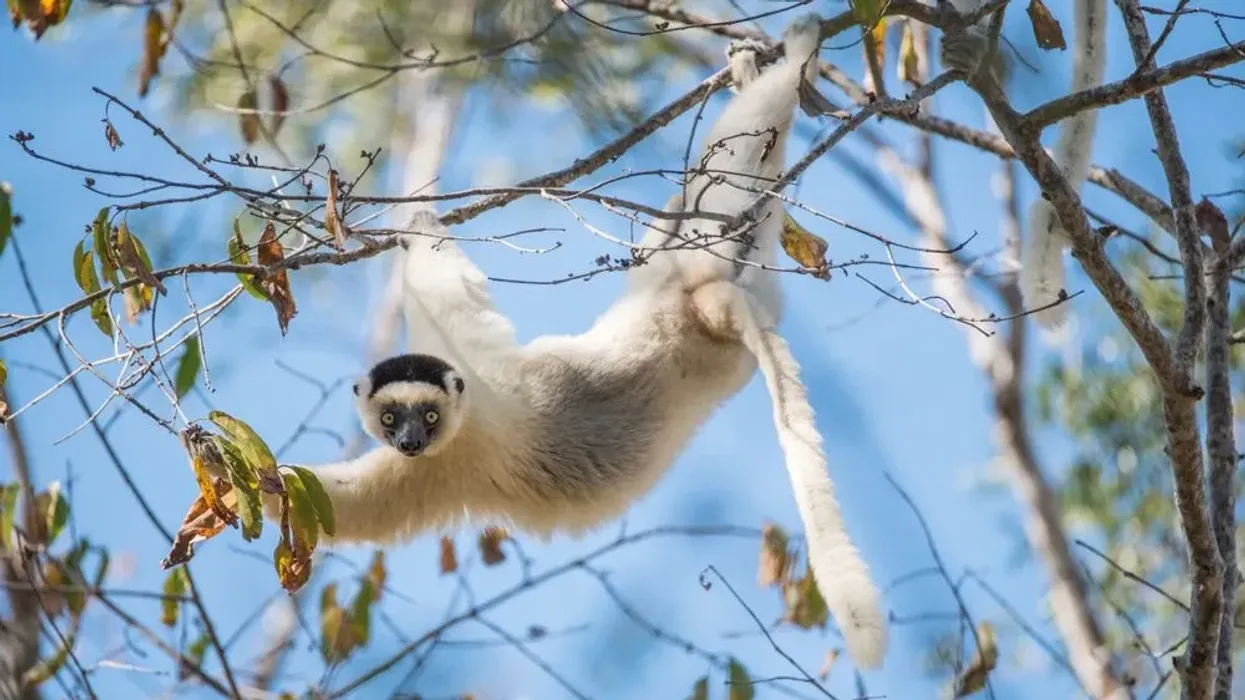Fun Verreaux's Sifaka Facts For Kids

Content
- What type of animal is a Verreaux's sifaka?
- What class of animal does a Verreaux's sifaka belong to?
- How many Verreaux's sifakas are there in the world?
- Where does a Verreaux's sifaka live?
- What is a Verreaux's sifaka's habitat?
- Who do Verreaux's sifakas live with?
- How long does a Verreaux's sifaka live?
- How do they reproduce?
- What is their conservation status?
- What do Verreaux's sifakas look like?
- How cute are they?
- How do they communicate?
- How big is a Verreaux's sifaka?
- How fast can a Verreaux's sifaka move?
- How much does a Verreaux's sifaka weigh?
- What are the male and female names of the species?
- What would you call a baby Verreaux's sifaka?
- What do they eat?
- Are they loud?
- Would they make a good pet?
- Did you know...
- Why are Verreaux's sifakas endangered?
- How did Verreaux's sifakas get their name?
The Verreaux's sifaka (Propithecus verreauxi) is a species of lemurs of the family of Indriidae. Mostly found in the western and southwestern parts of Madagascar, Verreaux's sifakas are found in rainforests, dry deciduous forests, and dry and spiny forests.
These lemurs are known for their leaping technique used for movement and are always found in a small group of two to eight Verreaux's sifakas.
Their tails are as long as their bodies and their tails help them to keep their balance while leaping from different trees to trees. The Verreaux's sifaka nocturnal and arboreal nature makes them the perfect candidate to show off their leaping.
Sifakas are also known to leap on the ground.
They leap along the ground in a forward and sideways movement. This lemur is so acclimated to living in the trees that the primate only knows how to leap on the ground as it doesn't know how to walk around.
The reproductive nature of this species is unique as these lemurs are fully female-dominant during the season. Sexual maturity is reached at about two and a half years.
The dominance is clearly visible when females reach maturity. This animal species are known to live in small groups and within these groups of primates, females are only known for breeding with the dominant male during reproduction season.
The females of this lemur species are similar in size and color to male lemurs but are quite dominant over the male species. To preserve these unique lemurs in their natural habitat, it is necessary to save their home range.
However, there has been a failure in doing so. Due to the continuous decline in the numbers of the Verreaux's sifaka, IUCN has categorized this species as Critically Endangered.
For more relatable content, check out these gopher facts and nutria fun facts for kids.
Verreaux's Sifaka Interesting Facts
What type of animal is a Verreaux's sifaka?
Verreaux's sifaka lemurs are medium-sized primates found in Madagascar.
What class of animal does a Verreaux's sifaka belong to?
The Verreaux's sifaka (Propithecus verreauxi) falls under the class of Mammalia in the kingdom of Animalia. It is a member of the family Indriidae.
How many Verreaux's sifakas are there in the world?
The number of these lemurs found in the Madagascar island is not known. However, they are in critical danger currently, and the lemur species is on the verge of extinction.
Where does a Verreaux's sifaka live?
The Verreaux's sifaka locations include different forests of the western and southwestern regions of the Madagascar island. The lemur is found along the Tsiribihina River in central-western Madagascar and southwards to the Andohahela region.
What is a Verreaux's sifaka's habitat?
The habitat of the Verreaux's sifaka primate species includes deciduous and evergreen forests. Wet and dry habitats throughout southwest Madagascar are also a chosen habitat for the Verreaux's sifaka. Verreaux's sifakas are also found in captive breeding environments.
Who do Verreaux's sifakas live with?
These primates are known to live in a group of two to eight individuals. Sometimes a larger group of these primates of around 13 individuals can also be seen. The group usually consists of five to seven adult females, two to three adult males, and some young lemur. The group consists of a single dark-chested male.
This male is seen mating with a group of females. The group also contains one or two subordinate males. Subordinate males are clean-chested males.
How long does a Verreaux's sifaka live?
The life span of these primates in the wild is not known. These animals stay conspicuous in their tree habitats.
In captivity, the lemur is known to live for an average age of up to 18 years. The longest living specimen of these animals lived for 23.5 years. The life span is similar to other sifakas.
How do they reproduce?
During the breeding season, females only breed with the dominant male of the group. The social hierarchies formed are changed during the breeding season. Subordinate males may fight with alpha males.
The reproduction season of this lemur is from January and March. The gestation period for females is 130-140 days after which females give birth to one single young. Mothers carry the young after birth for two to three months on the abdomen. After this, for the next three months or so, the infant rides on the mother's back.
It takes six months for the infant to become independent. The mating sequence is quite long. Both males and females sifakas reach sexual maturity at three years of age.
Females are known for their scent marking to attract males, however, males scent mark as a form of communication. Verreaux's sifaka sexual dichromatism, as stated by extensive research, has found that both sexes are alike.
A Verreaux's sifaka male fights with other males for the chance to mate with the females.
What is their conservation status?
The conservation status of the Verreaux's sifaka (Propithecus verreauxi) is categorized as Critically Endangered by the IUCN Red List.
Habitat loss and degradation are the main causes of the recent decrease in the population of Verreaux's sifakas. The Verreaux's sifaka habitat suffers from intense agricultural activities.
The Verreaux's sifaka conservation techniques are failing as slash-and-burn agriculture in the deciduous forests of Madagascar is still happening on a huge scale. Also, commercial logging, overgrazing by livestock, and charcoal manufacturing have degraded the habitats of the Verreaux's sifaka lemur. Habitat climate change has also led to the decline in the population of the species.
Predators in the wild are also sometimes the cause of the decrease in numbers of Verreaux's sifakas.
Verreaux's Sifaka Fun Facts
What do Verreaux's sifakas look like?
The Verreaux's sifaka (Propithecus verreauxi) has white fur on the body. The hairless, black face is contrasted well with a hint of yellow coloration. The hands and feet of this species are black.
The long, thick, and soft fur on the body is contrasted with a dark brown head crown which is also found on the back of the neck. The coat is thinner on the belly, underarms, and chest. The gray-colored skin is easily seen because of the thinner coat on the chest.
A Verreaux's sifaka female is similar in size and color to a male. However, males have a faint reddish-brown chest patch. They have partially webbed feet.
Like the Verreaux's sifaka, the Coquerel's sifaka is known for bipedal hopping with its arms thrown out to the sides. It helps when balancing.
How cute are they?
They are considered cute by many.
How do they communicate?
Communication is done by voice and the bark which sounds like sifaka is mainly used by the leader of the pack when intruders are nearby.
Communication is also established by scent marking. This process is used for marking territories, attracting mates, and claiming food.
How big is a Verreaux's sifaka?
The Verreaux's sifaka length has a range of 17.7-21.6 in (45-55 cm). The length of the tail is 22-24 in (55.8-60.9 cm). The tail is as long as the whole body of the Verreaux's sifaka. However, the Verreaux's sifaka primate height is not known.
The largest lemurs on the planet called the indri have a range of length of 25-28 in (63.5-71.1 cm).
How fast can a Verreaux's sifaka move?
The speed is not known. However, they hop pretty quickly when foraging for food on the ground. They are also quick when jumping from one tree to another.
How much does a Verreaux's sifaka weigh?
The Verreaux's sifaka (Propithecus verreauxi) weight is 6.6-15.4 lb (3-7 kg).
A member of the same genus Propithecus and found in Madagascar similar to the Verreaux's sifaka lemur, the Coquerel's sifaka has a range of weight from 7.7-9.3 lb (3.5-4.2 kg). The Coquerel's sifaka is also Critically Endangered currently. It is part of the same family Indriidae.
What are the male and female names of the species?
Males and females of the Verreaux's sifaka (Propithecus verreauxi) are not given different names.
What would you call a baby Verreaux's sifaka?
A baby Verreaux's sifaka primate is called an infant or young.
What do they eat?
The diet of a Verreaux's sifaka includes leaves, bark, and flowers. The diet may also include fruits and other high nutrition items. It is a strictly herbivorous animal.
The lemur is known to forage for food with their group in the morning and late afternoon. This process becomes easy as the species live in the trees where the food supply is greater.
The natural predators of the Verreaux's sifaka lemur include fossas, harrier hawks, and domestic dogs.
Are they loud?
Found in Madagascar, Verreaux's sifaka lemurs are known to produce loud calls to scare away intruders and also to establish contact with other group members.
Would they make a good pet?
Although not considered as pets in homes, captive breeding of the Verreaux's sifaka has been completed successfully. However, the decreasing population is a cause for concern for this lemur of the family Indriidae.
Did you know...
Although found in fewer numbers of the Verreaux's sifaka, spiny forest and dry deciduous forest of western Madagascar and rainforest all over are deemed as their true habitats.
Sifaka lemurs are known for their leaping ability and different colored limbs and bodies, even the heads of some of the species are multicolored. This species of lemurs are known for their vertical clinging and leaping. They maintain an upright position leaping from one tree trunk to another tree trunk.
During the dry season, sifakas exhibited significant losses of body mass and fat due to the loss of diet and food.
Why are Verreaux's sifakas endangered?
IUCN Red List has given the status of Critically Endangered to the Verreaux's sifaka lemur. Habitat change has been the main reason for the decline of the population of this species.
How did Verreaux's sifakas get their name?
The reason for the nomenclature of these species of lemurs is not known. The lemurs of the genus Propithecus are known as sifakas.
Here at Kidadl, we have carefully created lots of interesting family-friendly animal facts for everyone to discover! For more relatable content, check out these mongoose facts and gopher fun facts for kids.
You can even occupy yourself at home by coloring in one of our free printable Verreaux's sifaka coloring pages.
madagascar
Get directionsWe Want Your Photos!
See All
Bachelor of Arts specializing in English

Ritwik BhuyanBachelor of Arts specializing in English
A skilled content writer, Ritwik holds a Bachelor's degree in English from Delhi University. He has refined his writing abilities through his past experience at PenVelope and his current role at Kidadl. In addition to his proficiency in writing, Ritwik has pursued his passion for flying by achieving CPL training and becoming a licensed commercial pilot. This diverse skill set highlights his commitment to exploring multiple fields. Ritwik's experience in the aviation industry has provided him with a unique perspective and attention to detail, which he brings to his writing.
Postgraduate Diploma in Management

Sakshi RaturiPostgraduate Diploma in Management
Sakshi has experience in marketing strategy, social media planning, and recruiting industry experts for capstone projects, she has displayed a commitment to enhancing their skills and knowledge. She has won multiple awards, including a Certificate of Appreciation for Creative Writing and a Certificate of Merit for Immaculate Turut, and is always seeking new opportunities to grow and develop.
Disclaimer
1) Kidadl is independent and to make our service free to you the reader we are supported by advertising. We hope you love our recommendations for products and services! What we suggest is selected independently by the Kidadl team. If you purchase using the Buy Now button we may earn a small commission. This does not influence our choices. Prices are correct and items are available at the time the article was published but we cannot guarantee that on the time of reading. Please note that Kidadl is a participant in the Amazon Services LLC Associates Program, an affiliate advertising program designed to provide a means for sites to earn advertising fees by advertising and linking to Amazon. We also link to other websites, but are not responsible for their content.
2) At Kidadl, we strive to recommend the very best activities and events. We will always aim to give you accurate information at the date of publication - however, information does change, so it’s important you do your own research, double-check and make the decision that is right for your family. We recognise that not all activities and ideas are appropriate for all children and families or in all circumstances. Our recommended activities are based on age but these are a guide. We recommend that these ideas are used as inspiration, that ideas are undertaken with appropriate adult supervision, and that each adult uses their own discretion and knowledge of their children to consider the safety and suitability. Kidadl cannot accept liability for the execution of these ideas, and parental supervision is advised at all times, as safety is paramount. Anyone using the information provided by Kidadl does so at their own risk and we can not accept liability if things go wrong.
3) Because we are an educational resource, we have quotes and facts about a range of historical and modern figures. We do not endorse the actions of or rhetoric of all the people included in these collections, but we think they are important for growing minds to learn about under the guidance of parents or guardians.







